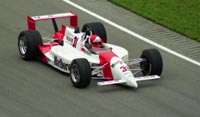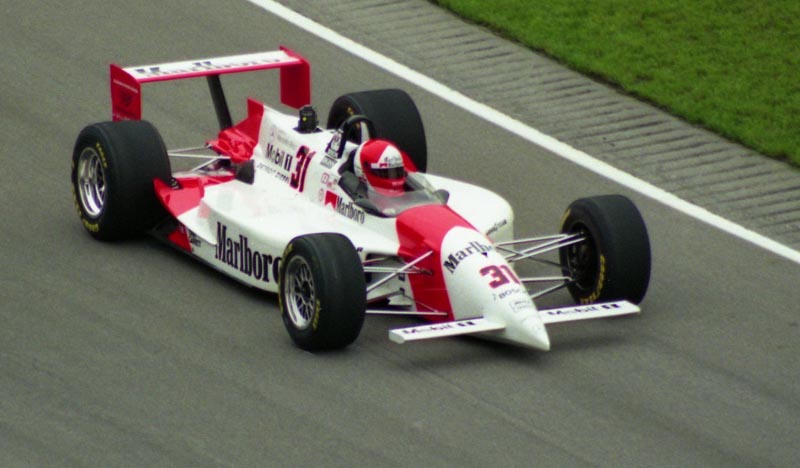Mercedosaurus Rex at Indianapolic Park
Part 23: The loose ends that didnít fit in anywhere else and the epilogue
Author
- Henri Greuter
Date
- April 29, 2010
Related articles
- March-Alfa Romeo 90CA - Fiasco Italo-Brittanico, by Henri Greuter
- March-Porsche 90P - The last oddball at the Indianapolis Motor Speedway, by Henri Greuter
- Penske-Mercedes PC23-500I - Mercedosaurus Rex at Indianapolic Park, by Henri Greuter
- Introduction
- Part 1: Penske Racing at Indianapolis - new standards
- Part 2: Ilmor Engineering at Indianapolis
- Part 3: Mercedes, Benz and Mercedes-Benz at Indianapolis up until 1993
- Part 4: Equivalency formulas - waiting for things to go wrong
- Part 5: Stock blocks - keeping them rolling and promoting 'Born in the USA' technology
- Part 6: Indianapolis 1991 - Chevy And Rich Team owners
- Part 7: The Speedway narrowed, its speeds lowered
- Part 8: The forerunner
- Part 9: Pre-May '94 plans
- Part 10: Penske PC23 - a home for the engine
- Part 11: The 1994 Indycar season until mid-April
- Part 12: The unfair advantage and when others have it
- Part 13: Practice during the 1994 'Month of May'
- Part 14: Other bespoke-design 209s
- Part 15: From the last weekend of May '94 to the end of the season
- Part 16: Could the Mercedes Benz 500I have been stopped in time?
- Part 17: Creating an extinct species without it being forbidden, initially at least
- Part 18: The 1995 '500' - Did the Mercedosaurus bite its masters after all?
- Part 19: A possible twist of fate for Rahal-Hogan and Penske as a legacy of the 500I
- Part 20: Re-evaluation of our verdict
- Part 21: PC23's further active career after 1994
- Part 22: USACís points of views and some answers
- Part 24: "Plan your work; work your plan" - Chuck Sprague on the PC23
- Appendix 1: Specifications
- Appendix 2: Car and driver appearances and performances during the Month of May 1994
- Appendix 3: Chassis, entry, practice and race numbers in 1994
- Appendix 4: PC23's 1994 results sans Mercedes Benz 500I
- Appendix 5: PC23's 1995-'96 results sans Mercedes Benz 500I
- Appendix 6: A reflection on the PC23 chassis used by Team Penske in 1994
- Appendix 7: A review of Beast by Jade Gurss
Who?Al Unser Jr What?Penske-Mercedes PC23-500I Where?Indianapolis When?1994 Indianapolis 500
|
 |
Why?
Never since the STP turbines had any car entered at Indianapolis created such an uproar because of its engine. An engine that was permitted according to the USAC rules but that created a lot of controversy once it finally was used and turned out to be so superior.
A superiority that was big yet at the same time not as big as it appeared. In practice the cars weren't devastatingly faster than anything else. It had been predicted to create a larger gap because of its power advantage. It was one year later when we finally found out that the PC23 chassis was not at all ideal for the Indianapolis Motor Speedway and didnít do the power of the 500I justice. It is very likely that if it wasnít for the power advantage of the Mercedes 500I, the PC23 would have been slower, perhaps even unable to qualify.
The project was prepared in secrecy but even when it was public, much about it was kept secret. The curtain hiding a lot of those secrets finally was raised the year later when the engine was effectively outlawed.
The engine was built in secrecy and it very likely had a single chance to succeed. USAC had a policy to control engine outputs and retaining a fair amount of equivalency for different types of engines. If it didn't interfere immediately to take away the large advantage of an exclusive engine, USAC could be counted upon to react in time for the next year, no matter if the engine in question had won the race yes or no. In no other year any purpose-design pushrod 209 would have such a large power advantage over its quadcam and/or stockblock-heritage opposition as in its debut year. It was pretty much now or never for the 265E/500I in its first year of existence.
And thatís exactly what happened.
We can only wonder what would have happened if the awesome power of the 500I had been employed in a 1994 chassis that did handle properly at Indianapolis, let alone what would have happened if the engine had been fitted in a purposely designed chassis.
The Ilmor 265E a.k.a. Mercedes Benz 500I, however, appeared at a wrong time, and perhaps with the wrong team to stand much of a chance for the future.
Ever since the late 80s and early 90s the seeds of controversy at the Indianapolis Motor Speedway had been sown. It is difficult to pinpoint where that exactly began. One of the main problems was the limited availability of the engine of choice to succeed in CART and at Indianapolis: the Ilmor Chevrolet. Partly commissioned by (of all people) Roger Penske, the engine debuted in 1986 and after a not too impressive early start became the powerplant to have during í87. The problem was, however, it was exclusive to Penske. Newman-Haas and a few selected teams were added in later years. Alternatives like the Judd and the improved Cosworth DFS weren't good enough, the Porsche V8 was exclusive to the Porsche team, the Alfa Romeo V8 wasn't sorted yet and also exclusive to Alfa.
Then, in 1991 Indianapolis saw one of the smallest entry numbers in years, leaving many drivers without a drive, including former winners and Speedway legends. Some of them tried to find rides in backup cars run by the lucky teams with Ilmor-Chevies. But Chevrolet told its customers not to hire out any backups to unassigned drivers since they lacked the capacity to maintain more engines that the nominated ones. For many of the disgruntled fans CART became synonymous for ďChevy And Rich TeamownersĒ.
The availability of the Ilmor Chevy was much less of a problem in 1992 (unless you were Pat Patrick). In the meantime, an improved version of the engine was introduced that year but, again, it was only made available to Team Penske. If their many victories on the CART trail hadn't been enough yet, now they were the only ones with the supposedly best engines.
New Speedway president Tony George (in charge since 1990) didnít like at all what he saw. The many exclusive or limited-availability deals were among the things he opposed. Also the fact that CART tried to push their demands on how the Speedway should be functioning were much to his dislike. In 1993 the first talks about his plans to organize a rival series of which Indianapolis would be part began to arise.
These plans were announced in March 1994 and no doubt would have been the center point of discussion had Penske not unveiled his Mercedes deal in mid-April at a press conference held at, of all places, the Indianapolis Motor Speedway Museum.
When you win youíre popular. Win too often and you will be much less liked if not hated. Such feelings towards Roger Penske were rapidly growing among the race audience. To a number of traditionally orientated race fans, he represented exactly what they didnít like about CART: the wealthy team owner trying to organize everything according to his plans, assuring himself of the best material exclusive to his team and only reluctantly sharing the goods with the opposition. The limited availability of his own cars to other teams, his share in the Ilmor organisation, and thus his share in deciding how many other teams and which teams could have a Chevy as well while having the Chevy/B exclusive to him. Some of those accusations weren't entirely correct and there is a lot that Roger has done over the years in order to enable others to compete as well.
Name it all, Roger had things organized well for himself but it gave the smaller teams little if any chance to be competitive at Indianapolis. Then he came with the Mercedes-Benz 500I, using the rules intended to help the smaller teams. It was one of the finest displays of Roger Penskeís cleverness in making the most out of the rules, turning a possible disadvantage into an advantage for himself alone. It also showed the entire racing world how obsessed Roger is with winning at Indianapolis as much as possible during his life time, using or abusing (depending on how you think of the man) the rules to his advantage.
Having said that, with such a commitment to succeed, and with going as far in that commitment as Roger Penske did, it was unavoidable that he was going to be as successful as he eventually became at the Speedway. When you do things right like Roger Penske enabled and allowed his team to do, it isnít that strange that he got the results that come with doing so.
It is nearly certain that the existence of the Mercedes-Benz 500I and the way it was used at Indianapolis in 1994 has had a negative influence on the tug of war between CART and IRL. In many ways, the 500I perfectly showed the anti-CART lobby what it was all about in CART: big money. It may have made a difference if the 500I had been branded with an American company name on its cam covers. And if it had been made available to more teams than Penske, who knows what might have happened.
The 1994 Penske-Mercedes Benz remains one of the most incredible stories in the history of the 500 miles of Indianapolis, and for a multitude of reasons. Given the importance of Indianapolis, it also became one of the most incredible stories ever in motor racing history. From the drawing table to the winnerís circle within less than a year, a feat rarely achieved before and ever since.

It is also surrounded by a number of controversies and it is very likely one of the contributing factors to the eventual split in American single-seater racing and all the negative backlash for open wheel racing in the United States.
However, as this project hopefully made clear: it was a story unlike anything else in Indianapolis history and motor racing history in general.
Now to my final words: to everyone who assisted me in gathering data, supplied info, photos, stories and whatever other kind of assistance I got over the past months and made this project possible, thank you so much everyone! It was fun for me to do and I hope all of you find satisfaction in the finished project and your much appreciated support.
